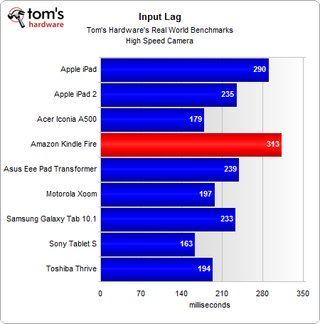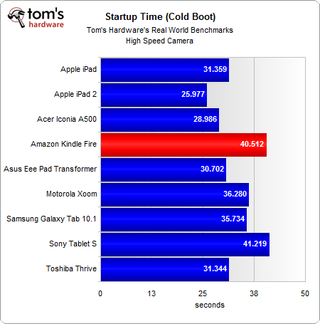The Amazon Kindle Fire: Benchmarked, Tested, And Reviewed
Benchmark Results: Real-World Performance

Our input lag test tends to be on the optimistic side, because I only measure the time it takes for the first letter of a word to appear on a screen. So, this score really reflects baseline performance. However, input lag tends to vary within a 100 ms range, which is why lag can be much higher than what we're showing here, especially if you can type well on a tablet.
Generally, input lag on the Fire hovers around 300 ms, which should be fine for most people. If you're typing fast, lag can increase to levels sufficiently high to be noticeable. Occasionally, high input lag also manifests itself when the Fire has to wake from standby or when you're trying to perform multiple commands in quick succession.
Given the relatively long time it takes to launch a browser, any performance issue is likely more related to software than hardware. The OMAP 4430 boasts as much processing power as Nvidia's Tegra 2, and we've seen plenty of tablets based on that SoC offering better scores. As it stands, the customized Amazon environment based on Android 2.3 benchmarks less impressively than Honeycomb.


Stay on the Cutting Edge
Join the experts who read Tom's Hardware for the inside track on enthusiast PC tech news — and have for over 25 years. We'll send breaking news and in-depth reviews of CPUs, GPUs, AI, maker hardware and more straight to your inbox.
Current page: Benchmark Results: Real-World Performance
Prev Page Benchmark Results: Battery Life And Recharge Time Next Page Benchmark Results: Wireless PerformanceMost Popular

